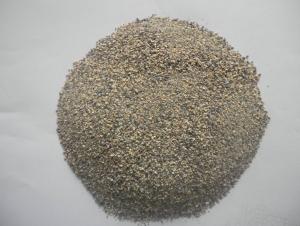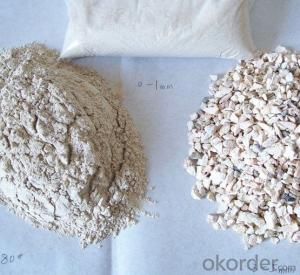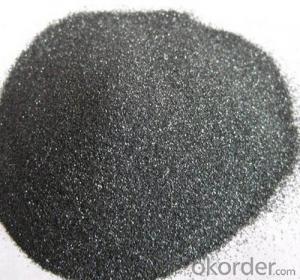Raw Materials for Refractory:Black Silicon Carbide, Black Emery Grains, Low Discount
- Loading Port:
- China main port
- Payment Terms:
- TT OR LC
- Min Order Qty:
- 25 m.t.
- Supply Capability:
- 2000 m.t./month
OKorder Service Pledge
OKorder Financial Service
You Might Also Like
Black Silicon Carbide, SIC ,silicon carbide powder ,micropowder
Black silicon carbide is produced at high temperature in an electric resistance type furnace with quartz sand and petroleum coke as its main raw materials. Its hardness is between fused alumina and synthetic diamond. Mechanical intensity of it is higher than fused alumina. It is brittle and sharp and sharp and heat conductivity in some degree. The abrasive made of it are suitable for working on cast iron, non-ferrous metal, rock, leather, rubber, etc It is also broadly used as refractory material and metallurgical additive
Applications
1. Metallurgical deoxidizer.
2. High temperature resistant materials.
3. As abrasive, abrasive tools can be used to such as grinding wheels, whetstones, grinding head, sand tile etc.
Advantages
1. Corrosion resistance, high strength, high hardness.
2. Good wear-resisting performance,resist to shock.
3. It is a cost-effective substitute for Ferrosilicon.
4. It has Multi-functions.
A: Remove oxygen from iron compound.
B: Adjust the carbon content.
C: Act as a fuel and provide energy.
5. It costs less than ferrosilicon and carbon combination.
6. It has no dust nuisance while feeding the material.
7. It can speed up the reaction.

- Q: How to use fire-resistant soil?
- It can live with water, not too sticky. Don't be too thin. It's best to put the stove in the inner wall.
- Q: How is grade of fire endurance divided?
- Fire resisting shutter is divided into Class A / B / C, and the relevant fire endurance are not less than 1.2 /0.9 /0.6 hours, see "General technical conditions for steel fire resisting shutter GB 14102-93". 4.3 4.3.1 Classification according to time of fire resistance 4.3.1 Ordinary steel fire resisting shutter (see Table 3) Table 3 and Category Code Refractory time hF1 1.5F2 2.04.3.2 Composite steel fire resisting shutter (see Table 4). Table 4 and Category Code Refractory time hF3 2.5F4 3.04.4 Classification according to refractory time and smoke prevention performance 4.4.1 Ordinary steel fire and smoke resisting shutter (see Table 5) Table 5 category and code refractory time h smoke leakage (20Pa differential pressure) FY1 1.5 ≤0.2m3 / m minFY2 2.0 ≤0.2m3 / m min4.4.2 composite steel fire and smoke resisting shutter (see table 6) table 6 category and code refractory time h smoke leakage (20Pa pressure) FY3 2.5 ≤0.2m3 / m minFY4 3.0 ≤0.2m3 / m min Excerpt completed. Fire shutter used as fire compartment has a fire resistance of 3 hours, and fire shutter set on the upper opening part on the firewall has a fire resistance of 1.2 hours. **** Materials with fire resistance of 3.0 hours are called AAA refractory material (back fire surface). "Building Conventions" have mentioned in places where it is really difficult to set a firewall, fire shutters can be used to separate fire compratment. When using fire shutters whose back surface temperature rise is included as the judging criteria of fire resistance, its fire resistance should be not less than 3.00h; When using fire shutters whose back surface temperature rise is not included as the judging criteria of fire resistance, independent protection of closed automatic water spraying system should be set on the both sides of the shutter, and the duration of water spray should be not less than 3.00h. In summary: Fire shutter is divided into: Grade AAA, A, B and C
- Q: How to divide the materials according to the National Fireproofing Material Standard?
- Each country has its own fire safety standards, I do not know which country's standard do you want to know, and each country of fireproof material to the division level is not the same. GB GB 8624, the German standard DIN 4102-1, the British standard BS 476, French standard NF P92 -501 and so on. GB 8624 is Chinese building materials and grade of combustion performance. The information coming form fire resources network (FireTC.
- Q: What is the difference in the nature between the refractory material and thermal?insulation?material
- thermal?insulation?material is a material which has a strong impedance to the heat flow. the nature of the material requires that the material can isolate the delivery of thermal, and the low heat conductivity coefficient and expansion coefficient of the non-metal material.refractory is good in heat resisitance and chamical erosion but not high temperature resistance. Requirements on nature is still in high temperature.
- Q: Is the ball mill used in production of refractories?
- Refractory is a kind of non-metallic material that is of resistance to thermal shock and chemical erosion, low thermal conductivity and low expansion coefficient. The refractoriness of the refractory is not less than 1580℃. The usage of the refractory is broad. Refractory materials include refractory bricks and powders. Abandoned refractory bricks can be recreated as new bricks after they are crushed by a crusher and grinded by a ball mill. The ball mill and crusher are needed to grind and crush the material in the production of the refractory. The ball mill produced by Zhengzhou Xinhai Machinery Manufacturing Co. has excellent performance and there are many successful cases in Inner Mongolia, Heilongjiang and Guangdong. At the request of the national environmental policy, the company adjusts the equipment details, allowing the equipment to ensure the volume of production while reduce energy consumption.
- Q: What materials are needed to make the amorphous refractory bricks?
- The amorphous refractory brick is composed of a certain proportion of aggregate and powder, a binder and an additive, and it can be directly used or used after allocation with some liquids. The amorphous refractory brick is a new type of refractory material without calcination, its refractoriness is below 1580℃.There is a wide variety of refractory materials. According to the production method and usage thereof can be divided into concrete, castable, plastic refractory, ramming refractory, gunning mix, sling refractory, coating material, dry ramming mix , fire clay, and all kinds of repairing mass(Asphalt combined with large surface charge compensation, Martin also belongs to the shape of the amorphous refractory material).
- Q: who knows how to classify the fire resistant levels of fireproofing material?
- Materials used in construction are called construction materials. The combustion performance of construction materials refers to all physic and chemical changes happened when burning or contacting fire, the properity is measured by combustibility of material surface and flame transmission, heating, smoke,charring, weightlessness, and the producing of toxicity resultant. Our national standard GB8624-97 classifies the combustion performance of construction materials into following several levels. Class A: Incombustible building material, class B1: Nonflammable building material, class B2: Combustible?building?materials, class B3: Inflammability construction materials, generally speaking: first fire resistant level construction is the mixed construction of reinforced concrete structure or brick wall and steel concrete structure; second fire resistant level construction is the steel structure roof truss, reinforced concrete column or mixed structure made by brick wall; third fire resistant level construction is the wood and brick made by wooden roof and brick wall; fourth fire resistant level one is the combustible?structure made by wooden roof, hard-comnustible component wall.
- Q: What are the differences between first-level fire-resistant materials and second-level fire-resistant materials?
- The combustion performance of materials could be divided into: A( noninflammability), B1(flame retardancy), B2(flammability), B3(inflammability). Building materials are divided into four ranks according to these properties. 1. In accordance with Code for Design of Building Fire Protection(GBJ16-1987)(revised edition in 2001), fire hazards in producing and storage can be divided into five types. In Fire Prevention Code of Petrol Chemical Enterprise Design(GB50160--1992)(revised edition in 1999), classification of fire hazards is also achieved according to the hazards of materials that have been using, producing and storing. Measures in prevention of fire explosion could be taken from the perspectives of fire separation, fire resistance level of structures, allowable floors, safe evacuation, and fire extinguishing facilities based on different levels of fire hazards. 2. Four fire resistance rating of buildings are listed in the book Code for Design of Building Fire Protection. And specific stipulations are made to the fire resistance of main elements of buildings, such as bearing walls, beams,pillars, and floors. When designing a building, if permitted, refractory materials of high-rank should be adopted in those buildings which have high potential fire hazard and a lot of combustible material and valuable equipment. While making sure fire resistance rating, the duration of fire resistance of each elements should meet its requirements.
- Q: What's the A class fireproof and thermal inuslation matertial for external wall?
- It is a kind of green and environmental protection inorganic material, free of harmful substances like asbestos, benzene, formaldehyde, etc. Its fire resistance can be up to A1grade non-combustible material, which means it can endure the highest temperature of 1400 ℃. It is thermal insulating with low heat conductivity and high heat storage coefficient. It has good weather resistance, finished product stability, anti hollowing, crack resistance, wind pressure and shock resistance with the same service life as buildings of 70 years. It is water-fast and moistureproof, breathable but waterproof, and fungusproof without influence from steam. It is convenient in construction which omits many procedures of panels construction. Once the second plastering is finished, the construction is completed, which greatly shortens the construction period. It has good adhesive property with various base planes, and meanwhile its external exposed surface can choose coating, facing brick, aluminum sheet, marble, etc. It saves money. Excellent construction technology reduces the construction cost. It effectively prevents the panels from leakage at the external wall, window, eave, etc. which saves the subsequent maintenance fund. It provides timely delivery. With sufficient supplies of raw materials and convenient production, it is fast in delivery.
- Q: Where is the development of refractory industry?
- The rapid development of continuous casting technology of its related @ China @4 honing refractories develop and increase in variety and quality, continuous development of refractories for the continuous casting billet continuous casting production and quality have a significant impact. Especially, the completion and operation of Baosteel have greatly promoted the technological progress of refractory materials in China, and the refractory materials for continuous casting have made great progress both in variety and in quality.
Send your message to us
Raw Materials for Refractory:Black Silicon Carbide, Black Emery Grains, Low Discount
- Loading Port:
- China main port
- Payment Terms:
- TT OR LC
- Min Order Qty:
- 25 m.t.
- Supply Capability:
- 2000 m.t./month
OKorder Service Pledge
OKorder Financial Service
Similar products
Hot products
Hot Searches
Related keywords


























